Alabama
Became territory: March 3, 1817
Became state: December 14, 1819
Many of the varieties of railroad certificates known for this state come from the Mobile & Ohio Railroad. Unlike most states, the remaining varieties are spread sufficiently so the specialist has a fairly wide range of Alabama railroads to collect. There are limited numbers of pre-Civil War certificates.
|
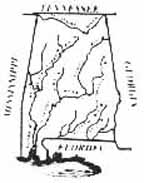
Alabama is one of the easiest of all state seals to identify, The seal shows a map of the state with its rivers and names of surrounding states. The Alabama name often appears In imitative versions.
|
Alaska
Became district: May 17, 1884.
Became territory: August 24, 1912
Became state: January 3, 1959
No collectible railroad certificates are known from companies to have incorporated in the state. Fortunately for collectors, there were a few railroads that incorporated elsewhere and operated in Alaska. Overall, Alaska is the second most difficult of all states to collect because certificates are of the highest rarity. Although probably allegorical in nature, it is possible that the railroad depicted on the state seal was the Alaska Central Railway, a pre-territorial company.
|
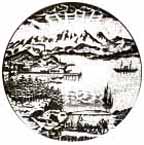
Territorial and state seals are the same. The seal shows northern lights, ship, bay, mountains, and a railroad. There are also symbolic representations of native people, mining, agriculture, fishing, and fur seals.
|
Arizona
Became territory: February 4, 1863
Became state: February 14, 1912
This is a popular state with collectors, even though few varieties of certificates would be considered common. This state is particularly popular for its mining-related certificates. Several railroad companies incorporated in this state, but operated elsewhere.
|
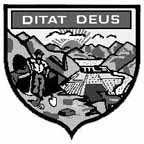
The seal shows a miner with pick and shovel at left and a processing mill beyond. The rest of the design shows irrigated fields, orchards, and cattle below a reservoir. The sun rises beyond mountains. Ditat Deus ("God enriches") at top.
|
Arkansas
Became territory: March 2, 1819
Became state: June 15, 1836
Certificates exist for many small railroads subsequently absorbed into successor companies that are now part of the Union Pacific system. Large numbers of logging railroads operated in the state, but are considered off-topic for this project.
|
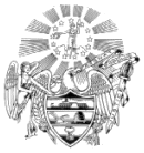
Shield with steamboat, beehive, plow, and sheaf of wheat. An eagle behind shield holds a ribbon with the words Regnat Populus ("The people rule.") Angel of Mercy left, sword of Justice right. Liberty at top holds staff and Liberty cap with sun rays behind. In engraved imitations, Justice may appear substantially larger and the sunrays smaller.
|
California
Ceded February 2, 1848 by Mexico after Mexican-American War
Became state: September 9, 1850
The number of collectors outstrips the number of available certificate varieties. Over one-third of all known varieties come from four companies: Atlantic & Pacific Railroad, Market Street Railway, Southern Pacific Railroad, and Western Pacific Railroad. Many of the remaining certificate varieties are hard to find. Only a few certificates show the state seal.
|
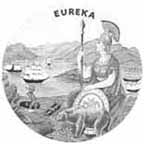
The word Eureka ("I have found it") appears above the goddess Minerva seated with shield and spear. Oddly tiny Grizzly bear in foreground. Miner works beyond. Ships in bay and mountains in distance
|
Colorado
Became territory: February 28, 1861
Became state: August 1, 1876
Like mining certificates, railroad certificates from Colorado are highly sought after, mainly because of its position at the pinnacle of narrow gauge mountain railroading. Many known varieties come from the narrow gauge Denver & Rio Grande and its descendent, the Denver & Rio Grande Western. Remaining varieties are not common.
|
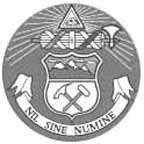
Shield with mountains and crossed pick and shovel. Sunrays originate from all-knowing "Eye of God" above fasces. State motto of Nil Sine Numine ("Nothing without Providence") on ribbon below shield.
|
Connecticut
Connecticut Colony: March 3, 1636
Became state: January 9, 1788
With its crucial location between New York and Massachusetts, Connecticut has seen more railroad incorporations than its small size would suggest.
|
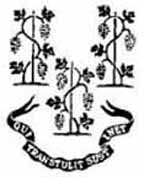
Usually portrayed as an elliptical design, the seal's primary "grape vines" are often incorporated less ostentatiously into certificates. The vines often resemble trees and the grape bunches are not always obvious. Ribbon at the bottom, with Qui Transtulit Sustinet ("He who transplanted still sustains"), often appears on certificates.
|
Delaware
New Sweden: 1638
part of New Netherland: 1664
leased by Province of Pennsylvania: 1682
Delaware Colony: June 9, 1732
Became state: December 7, 1787
Some of the largest companies in the United States have incorporated in Delaware due to liberal incorporation laws. Certificates specifically labeled as Delaware incorporations are relatively common. On the other hand, one would have an difficult time collecting a large number of railroad certificates from companies that actually operated within this small state
|
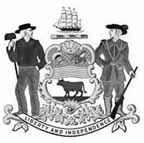
Shield with sheaf of wheat and ear of maize above ox. Ship under full sail above. Farmer left, rifleman right. Banner below reads "Liberty and Independence."
|
District of Columbia or Washington, D.C.
Formed by cession of land from Virginia and Maryland under enabling legislation: July 16, 1790
Became district: September 9, 1791
A handful of street railways are known to have incorporated in Washington, DC. None are currently known to display the district seal.
|
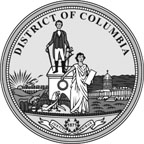
Central elements include a Statue of George Washington and a female holding a wreath and stone tablet. Other elements include a train crossing the Potomac, an eagle with a ribbon in its beak, a rising sun, the U.S. Capitol and a ribbon at bottom with the motto Justitia Omnibus ("Justice for all") and "1871."
|
Florida
Became territory: March 30, 1822
Became state: March 3, 1845
Like some western states, many of Florida's certificates originate from a few large, relatively modern companies. Florida is important among collectors of Southern states' material, so it is not possible to collect a large number of different varieties; there are just too few to go around.
|
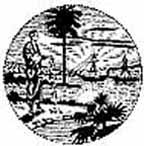
A female scatters flowers at left with a sabal palmetto tree beyond. In distance are sunrays behind a steamboat.
|
Georgia
Province of Georgia (aka Georgia Colony): April 21, 1732
Became state: January 2, 1788
Because of its advantageous terrain, this state has seen a moderate number of railroad company incorporations, especially in the post-Civil War era. Pre Civil-war certificates are highly sought after and generally difficult to find. While the state seal graces a large number of varieties of private and state-issued paper money, it is uncommon on railroad certificates.
|

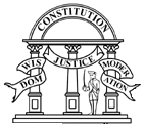
Georgia's state seal is a sparse design that has been particularly useful as a logo design. The design consists of three pillars supporting an arch with a military man holding a sword inside. Woven into the design are the words "Constitution," "Justice," "Wisdom" and "Moderation."
|
Hawaii
Kingdom of Hawaii: January 1, 1790
Republic of Hawaii: January 1, 1894
Became territory: April 30, 1900
Became state: August 21, 1959
This is the rarest of all states to collect. While narrow gauge railways were built on several islands, certificates from only a handful of officially incorporated companies are known. Several small railways served the docks and sugar cane plantations but were never incorporated separately. Three companies are known to date from the Kingdom of Hawaii period.
|
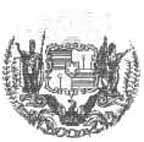
Central element is a shield with stripes in two quarters and a ball on a staff in the remaining quarters. Rising sun beyond. King Kamehameha left, Liberty and flag right. Eagle bottom. On official seals, the state motto, Ua mau ke ea o ka aina i ka pono ("The life of the land is perpetuated in righteousness") appears on a scroll at bottom.
|
Idaho
Became territory: March 3, 1863
Became state: July 3, 1890
Only a small number of railroad companies have incorporated in the state. If it weren't for companies that incorporated elsewhere and operated within the state, this would be an almost impossible state to specialize in.
|
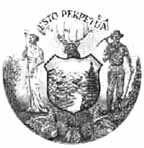
Shield with fir tree, river, and farmer plowing. Liberty with staff and Liberty cap left. Miner with pick right. Elk above shield. Esto perpetua ("It is forever") on ribbon above.
|
Illinois
Part of The Territory Northwest of the River Ohio (aka Northwest Territory): July 13, 1787
Became territory: February 3, 1809
Became state: December 11, 1816
An easy state to collect due to the large number of varieties available. The Illinois state seal is not a common image on railroad certificates.
|

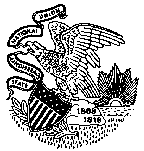
Eagle with shield holds ribbon in beak that reads "State sovereignty, National union." Rising sun beyond. Dates of territory and statehood status on rock. Unlike most states, the official Illinois seal has changed substantially since territorial times. The current seal from 1868 is the only one to show the sun.
|
Indiana
Became territory: May 7, 1800
Became state: December 11, 1816
There are abundant numbers of railroad certificates from Indiana, although the state seal appears only rarely.
|

 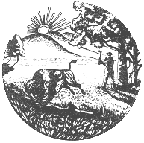
The seal shown is the first official seal and dates from 1963. Earlier seals are hard to find but contain the same general elements dating back to the 1870s on railroad certificates. Primary elements include a bison running right to left while a woodsmen chops a tree at right. The sun appears beyond, behind rolling hills
|
Iowa
Became territory: June 12, 1838
Became state: December 28, 1846
Several certificates are known from the years before the transcontinental railroad. The number of feeder railroads increased substantially after the Union Pacific / Central Pacific line opened. This state was an important source of income for several large railroad companies. The important and early Mississippi & Missouri Railroad is the source of several important autographs.
|
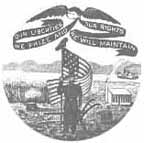
The central element of the seal is a citizen soldier holding a large American flag. Behind him are agricultural symbols including a field of wheat, a plow, and a sickle. A lead furnace also appears. Beyond is the steamer Iowa on the Mississippi River. Flying above is an eagle holding a ribbon that reads "Our liberties we prize, and our rights we will maintain."
|
Kansas
Became territory: May 30, 1854
Became state: January 29, 186
A large number of railroad companies were licensed to do business in the state. Many folded before laying track. Other than the AT&SF, only a moderate number are represented by certificates. A small number show the state seal.
|
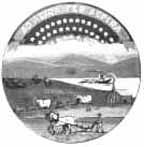
An intricate design with the quintessential Kansas farmer plowing in the foreground. Beyond is a wagon train heading west. Riverboat, cabin, and a herd of tiny bison. Ad astra per aspera ("To the stars through difficulties") above a double arch of 34 stars.
|
Kentucky
Kentucky County, Virginia: December 6, 1776
Became state: June 1, 1792
With the important Cumberland Gap and several immigrant routes, Kentucky saw the earliest and heaviest settlement west of the Appalachians. Its wealth of coal in both the eastern and western parts of the state spurred a large number of railroad company incorporations. The state seal, however, appears on only a tiny handful of certificates.
|
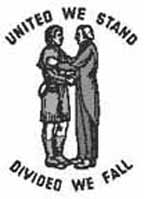
Two friends embrace, surrounded by words of the state motto. While the official design has remained more or less unchanged for over 200 years, the representation of the two men takes on a huge number of variations in unofficial uses.
|
Louisiana
Territory of Orleans: October 1, 1804
Became state: April 30, 1812
Like other southern states, these certificates tend to attract values a little higher than their scarcity would suggest.
|
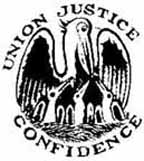
Pelican feeds chicks surrounded by words of the state motto. Very elaborate engraved variations of the seal are known on stocks and bonds.
|
Maine
Originally "Maine Colony" with a very contorted history of names and ownership
District of Maine: June 19, 1819
Became state: March 15, 1820
Certificates from Maine are concentrated among very large railroads such as the Maine Central and the Boston & Maine. Railroads are unlike the mining industry where large numbers of companies incorporated in Maine with operations elsewhere. Being at the eastern tip of the country, comparatively few railroads passed through Maine except for a few connecting with Canada.
|
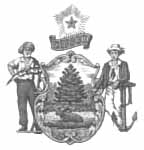
North star above with Dirigo ("I guide") above the central design of a shield with pine tree and resting moose. Farmer and scythe stand at left. Sailor and anchor right.
|
Maryland
Province of Maryland: 1632
Became state: April 28, 1788
The Baltimore & Ohio Railroad, founded in Maryland, has more varieties of certificates than any other company. There are numerous street railways, but because of the predominance of the B&O, there are relatively few major railroads known.
|
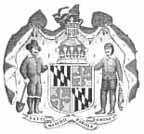
Reflecting its English colonial origin, the seal shows a shield with Lord Baltimore's coat of arms. An earl's crown and a helmet above. Farmer with shovel left. Fisherman with fish right. Ribbon with Fatti machii parole femine ("Manly deeds, womanly words.") The state motto variably appears in unofficial versions above and below the main design: Scuto bonae voluntatis tuae coronasti nos ("With favor wilt thou compass us as with a shield").
|
Massachusetts
The Colony of Massachusetts Bay: 1629
Province of Massachusetts Bay: 1686
Became state: February 6, 1788
With its long history, this state has a large number of certificate varieties recorded. There is a concentration of certificates among very large and old companies.
|

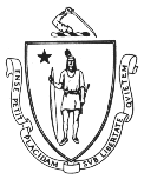
A large number of engraved variations of this seal are known on stocks and bonds. All seem to contain the central elements of the Indian holding a bow in his right hand. Above is a right arm holding a broad sword. A long ribbon below holds the words Ense petit placidam sub libertate quietem ("By the sword we seek peace, but peace only under liberty.")
|
Michigan
Became territory: January 11, 1805
Became state: January 26, 1837
Michigan is an "average" state in that the number of state specialists and the number of available certificates seems balanced. Extreme rarities tend to represent smaller operations located in the Upper Peninsula and mining-related operations in the west.
|
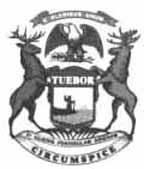
With numerous design elements, the Michigan seal offers a wealth of vignette variations on stocks and bonds. The main element is a central shield with a frontiersman and gun on a peninsula of land with the word Tuebor (I will defend) above. Below shield is the state motto, Si quaeris peninsulam amoenam, circumspice ("If you seek a pleasant peninsula, look around.") Left and right are standing elk and moose. Eagle above shield with e pluribus unum on ribbon above.
|
Minnesota
Became territory: March 3, 1849
Became state: May 11, 1858
On average, if a Minnesota railroad company is represented by any certificates, there are normally multiple varieties known. There are, however, only a moderate number of Minnesota companies represented by certificates. There seems to be a reasonable balance between collecting interest and the number of available certificates, so prices are generally moderate.
|
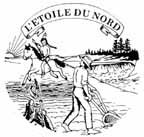
Man plows in foreground; Indian in loincloth rides horse beyond. Mississippi River, St Anthony Falls, pine trees and rising sun in distance. The phrase, L'Etoile du Nord ("Star of the north") appears at the top.
|
Mississippi
Became territory: April 7, 1798
Became state: December 10, 1817
The collecting of certificates from southern states' railroads is popular, but this state is fairly difficult. Most of the known certificates concentrate among a few major roads. Certificates from smaller companies are tough to find, especially with pre-Civil War dates.
|
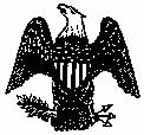
Eagle with olive branch and arrows in claws and shield on chest.
|
Missouri
Louisiana-Missouri Territory: March 3, 1805
Missouri Territory: June 4, 1812
Became state: August 10, 1821
Many companies are known to have incorporated within the state. The Katy (the Missouri Kansas & Texas) offer the most certificates. Although not as well-represented, the St Louis-San Francisco Railway Co and its several name variations offers several varieties. With the exception of those two companies many of the known certificates come from companies with small issuances. So, while it is extremely easy to collect several Missouri railroad certificates, it is very challenging to collect a wide variety. Overall, popularity among collectors sems modest.
|
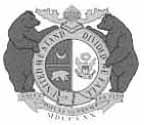
Circular belt with buckle supported by two bears. Above the belt are moose antlers. On the belt are the words "United we stand, divided we fall." Inside the belt is the United States coat of arms and a another bear. Below is Salus populi suprema lex esto, MDCCCXX ("The welfare of the people shall be the supreme law, 1820").
|
Montana
Became territory: May 26, 1864
Became state: November 8, 1889
It is hard to specialize in this state because there are so few railroad companies represented by certificates that incorporated in Montana. Conversely, there are numerous mining companies that issued certificates and worked the mountainous region of western Montana.
|
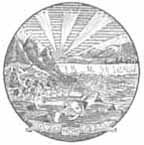
Mountains and Great Falls of the Missouri River in middle distance. Plow, miner's pick and shovel in foreground with Oro y plata ("Gold and silver") on ribbon below. Sunrays in far distance.
|
Nebraska
Became territory: May 30, 1854
Became state: March 1, 1867
Small railroad companies have certainly incorporated in Nebraska but the state has always been the home of major companies such as the Union Pacific and the Burlington, and their myriads of predecessors. While the state is not represented by a large number of certificates, a significant percentage of certificates are relatively easy to find.
|

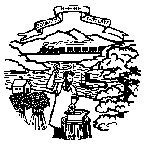
Man with hammer and anvil in foreground. Cabin and boat ascending Missouri River beyond. In far distance is the transcontinental railroad heading toward the Rocky Mountains. "Equality before the law" on a ribbon above. One of only two seals with a design element that can legitimately be assumed to represent a specific company (the Union Pacific Railroad.)
|
Nevada
Became territory: March 2, 1861
Became state: October 31, 1864
A long mining history and a key location on the first transcontinental railroad gives Nevada collectors quite a few collecting possibilities. Still, certificates with a Nevada imprint, especially railroads, are challenging to find.
|
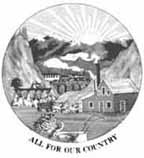
Plow, wheat, and sickle in foreground with a quartz mill beyond. Miner pushes ore from a mine. Train on trestle in distance. Sunrays from sun rising behind snowcapped mountains. "All for our country" below. (It seems likely that the railroad represents the Central Pacific portion of the transcontinental railroad.)
|
New Hampshire
Province of New Hampshire: 1629
Became state: June 21, 1788
A large number of certificates from a few companies are known. Some companies are represented by only a handful of certificates, making many companies difficult to collect.
|

Wreath of laurel surrounds a view of the frigate "Raleigh" in dry dock. Rising sun beyond. Vignette versions of this seal on stocks and bonds often show the ship at sea with the sails down.
|
New Jersey
Province of New Jersey: 1664
Became state: December 18, 1787
New Jersey ranks fifth in the number of identified varieties of railroad certificates. Like both Pennsylvania and New York, the New Jersey state seal appears frequently on railroad certificates.
|
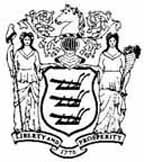
This seal has strong allegorical features and shows wide variations on stocks and bonds. All versions seem to show the main elements: central shield with three plows Standing Liberty at left with staff and Liberty cap, Prosperity (aka Ceres, Plenty) at right holds cornucopia. Horse head and helmet above shield. "Liberty and Prosperity, 1776" on ribbon below.
|
New Mexico
Became territory: September 9, 1850
Became state: January 6, 1912
Because of its low population and rough topography, the number of known railroad company incorporations in New Mexico is fairly low. A strict specialist would have a tough time collecting many certificates bearing the New Mexico imprint. On the other hand, predecessors of the two largest US railroads, the Union Pacific (via the Southern Pacific companies) and the Burlington Northern Santa Fe (via the former AT&SF), offer a fair number of certificates for state collectors with more generalist points of view. No railroad certificates are known that display a representation of the state seal.
|
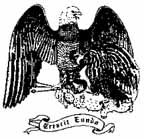
One of the few seals to include the seal design of another country. The large eagle with arrows in its talons represents the American eagle. Under its wing is the quintessential Mexican emblem: an eagle on a cactus holding a snake in its beak. Crescit eundo ("It grows as it goes") appears on a ribbon below.
|
New York
Province of New York: 1664
Became state: July 26, 1788
Over 2,000 railroad companies are currently known to have incorporated in or operated in New York. Of that number, over a third are represented by at least one certificate. That means New York is the easiest state to collect. That is not to say they are all easy to collect. In fact, because of the sheer numbers of companies, New York also represents the state with the largest number of extreme rarities.
|
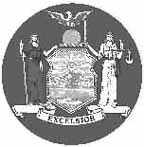
The strong allegorical designs and the heavy number of incorporations in New York have made this seal the second most imitated on U.S. railroad stocks and bonds. Liberty with staff and Liberty cap stands at left. Justice with scales stands at right. On the shield between is a view of ships on the Hudson River and the Hudson Highlands beyond. Eagle and globe above shield. Excelsior ("Higher") below shield.
|
North Carolina
Province of North Carolina: 1912
Became state: November 21, 1789
Unlike most southern states, there is no terrible shortage of North Carolina companies to collect. That is not to say that they are all easy to find. Pre-Civil War companies and dates are hard to find. Reconstruction-era state aid bonds are relatively plentiful, although they are generally sold in auctions without clear reference to their railroad involvement. Check the database for bonds listed under "North Carolina State of." Search also for state "aid bonds."
|

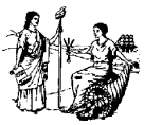
Allegorical standing Liberty at left with staff and Liberty cap. To the right is seated Plenty with a cornucopia. Tiny ship in far distance. Many, many variations of this allegorical design appear on certificates and pre-1870s paper money.
|
North Dakota
Became Dakota territory: March 2, 1861
Became state: November 2, 1889
A tough state to collect either as State of North Dakota or Dakota Territory. Because of very limited availability, any specialized collection of North Dakota railroads will commonly include companies that operated in North Dakota but incorporated in other states or provinces.
|
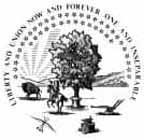
Indian on horseback chases bison near tree in open field. Plow and anvil in foreground. Setting sun in distance. State motto ("Liberty and union now and forever, one and inseparable") and 42 stars above.
|
Ohio
Part of The Territory Northwest of the River Ohio (aka) Northwest Territory: July 13, 1787
Became state: March 1, 1803
Ohio was the target of the first trans-Appalachian railroad effort, so it has the longest railroad history west of the mountains. With excellent topography for road-building, excellent farm land, and large coal reserves, every county in the state has seen rail service at one time or another. In excess of 1,200 railroad incorporations are known from Ohio; certificates are known from almost half.
|
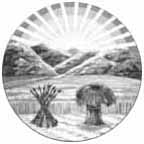
Standing sheaf of wheat and a similar-shaped group of 17 arrows. Cultivated fields in the Scioto River Valley beyond. Sun rises from behind Mount Logan in distance. A heavily imitated design due to the large number of railroads that incorporated in the state.
|
Oklahoma
Became territory: May 2, 1890
Became state: November 16, 1907
Small companies that operated exclusively in Oklahoma are very hard to find. If the specialist opens up collecting interest to companies that operated within the state, however, many certificates are collectible from companies like the Missouri Kansas & Texas, Missouri Pacific and all their predecessors.
|
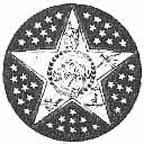
Large central star heavily ornamented with 45 smaller stars and goods representing the five Indian nations (Cherokee, Chickasaw, Creek, Choctaw, and Seminole.) Labor omnia vincit ("Labor conquers all things") in center.
|
Oregon
Became territory: August 14, 1848
Became state: February 14, 1859
Like many states, Oregon is not an easy state to collect. With its lumbering heritage, however, their are probably a large number of railroad-related certificates awaiting discovery that are currently disguised under timber company names.
|

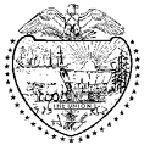
Conestoga wagon pulled by oxen above "The Union." Plow and pick in the foreground. Tree and ship (representing a departing British warship) in distance. Eagle above. Surrounded on the bottom by 33 stars.
|
Pennsylvania
Province of Pennsylvania (aka Pennsylvania Colony): 1682
Became state: December 12, 1787
The Great Seal of the State of Pennsylvania is seen on twice as many railroad certificates as any other state seal. Pennsylvania is second only to New York in the number of total known varieties of collectible railroad certificates. Roughly one in every ten Pennsylvania railroad certificates shows an imitation of the state seal.
|


This is the most heavily imitated of all state seals on railroad stocks and bonds by far. The most common vignettes you will see on Pennsylvania certificates resemble the above design which is the official "coat of arms" of the State of Pennsylvania. Officially, both horses are black. The majority seen on railroad certificates show black and white horses. The official "state seal" has no horses and is unknown of railroad or coal certificates.
|
Puerto Rico
Spanish colony prior to 1899
Became unincorporated U.S. territory: April 11, 1899
Only a meager handful of railroads are known from this unincorporated territory. None are known with a depiction of the territorial seal.
|
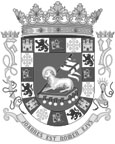
The Great Seal of Puerto Rico is a direct descendent of the coat of arms granted to the territory by the Spanish Crown in 1511 and is the oldest such herald still used in the Americas. Original religious elements have been softened, but the motto, Joannes est nomen ejus, ("John is his name") remains. This is a reference to Saint John the Baptist or San Juan Bautista, the original name of the island.
|
Rhode Island
Colony of Rhode Island and Providence Plantations: 1636
Became state: May 29, 1790
For such a tiny state, Rhode Island has had over 50 railroad companies incorporate in the state. Certificates are known from about half. (This state was formally known as "Rhode Island and Providence Plantations" until November, 2020.)
|
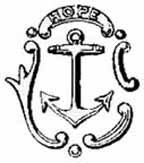
One of the few state seals with strong logo type designs. Rhode Island has a single anchor with the word "Hope" above
|
South Carolina
Province of South Carolina: 1712
Became state: May 23, 1788
Forming an important link along America's east coast, South Carolina offers a healthy number of collectible certificates for the state specialist. Pre-Civil War certificates are rare.
|
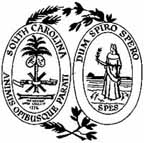
The most commonly seen "seal" seems to represent a combination of the obverse and the reverse designs of the 4-inch physical state seal. The left elliptical frame shows a palmetto tree surrounded by "South Carolina, animas opibusque parati" (
Prepared in mind and resources.") The right ellipse shows an allegorical Hope (Spes) standing with a laurel branch in her hand. Above are the words Dum spiro spero ("While I breathe, I hope").
|
South Dakota
Part of Dakota territory: March 2, 1861
Became state: November 2, 1889
As one might expect, South Dakota certificates are very limited in variety and tend to represent large, regional companies. Like North Dakota, no railroad certificates are recorded with a depiction of the state seal.
|
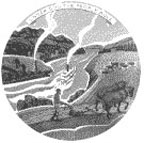
Farmer with a horse-drawn plow in foreground. Steamboat passes a smoking mill as it navigates upstream in the foreground. "Under God the people rule" on a ribbon above
|
Tennessee
Part of The Territory South of the River Ohio: March 26, 1790
Became state: June 1, 1796
Tennessee was the third state to be admitted to the Union after the thirteen original colonies, so it has had a long period of occupation and development. Its railroads suffered significantly, and often multiple times, during the Civil War. Pre-Civil War certificate are very hard to find. However, the state is represented by a respectable number of post-war certificates. That number is elevated substantially by companies that incorporated elsewhere, but crossed the state.
|

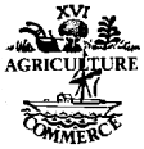
A plow surrounded by the words "Agriculture" and "XVI" (for 16th state) at top and a ship with sails down with the word "Commerce" below.
|
Texas
Republic of Texas: January 1, 1836
Became state: December 29, 1845
Texas is a giant state, and one that offered great opportunity for railroad building. Of course, within that huge region, many companies faltered and now offer limited numbers of certificates. With limited collectibles and enthusiastic collectors, there is high interest and elevated auction values. Even if you are lucky at auction bidding, assembling a large collection of Texas certificates will take patience
|

A single 5-point star is arguably the strongest logo-like design of all the state seals. Officially, the star is surrounded by olive and live oak branches. It is not a great exaggeration to suggest that the Texas star, with or without branches, has appeared in some form on a significant percentage of all official and unofficial documents produced in the state of Texas since 1845. The symbol is seen everywhere in the state.
|
Utah
Became territory: September 9, 1850
Became state: January 4, 1896
Theoretically, certificates from Utah railroads ought to date from as early as 1869 when the last golden spike of the transcontinental railroad was pounded in west of Ogden. However, the earliest Utah railroad certificates are not dated until a few years after that. To assemble a collection of many Utah certificates, you will need to enlarge your interests to the Union Pacific, Central Pacific, Western Pacific and D&RGW.
|
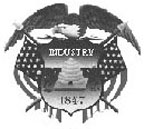
On the central shield is a beehive, the principal logo of the state of Utah. "Industry" and "1847" surround a beehive. 1847 is the date Mormons believers reached the Great Salt Lake. Behind the shield are two American flags. Above is an eagle with outstretched wings.
|
Vermont
Republic of New Connecticut: January 15, 1777
Republic of Vermont: June 2, 1777
Became state: March 4, 1791
Few certificates are known that specifically carry the Vermont incorporation. The number of collectible certificates can be enlarged if companies are included that incorporated elsewhere but operated within the state.
|
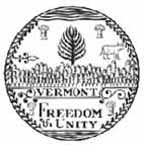
Central pine tree, cow, spear, and sheaves of wheat. The state motto, "Freedom and Unity" appears below.
|
Virginia
Virginia Colony: 1607
Became state: June 25, 1788
The Commonwealth of Virginia state seal is a popular element on many railroad certificates. Some Virginia certificates are known from small railroads, but the vast majority come from major roads including the C&O, N&W, Norfolk Southern, ACL, Seaboard, and other such companies.
|

An amazon representation of Virtus holds a spear and stands above the vanquished form of Tyranny. Below are the words Sic semper tyrannis ("Thus ever to tyrants").
|
Washington
Became territory: March 2, 1853
Became state: November 11, 1889
Like Oregon, one of the intriguing areas of possible new finds of certificates will include rail lines operated by timber companies. In general, certificates from full-fledged railroad companies that incorporated in Washington are hard to find. None are currently known that display the state seal.
|

Portrait of George Washington.
|
West Virginia
Originally part of State of Virginia
Became state: June 1, 1863
West Virginia broke off from Virginia during the Civil War. Many railroads existed prior to that time, so you will see many older "Virginia" railroad certificates issued from cities and towns that are now part of West Virginia. Nonetheless, West Virginia offers a substantial variety of railroad certificates, many from long-extinct companies. The large number of companies was due in part to its rugged terrain and in part to its huge reserves of high quality coal and hardwood timber.
|
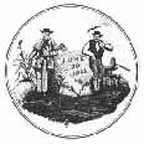
A large rock in the center with the date June 20, 1863. Farmer with plow and hunting apparel at the left. Miner with pick and anvil right. The official version has Montani semper liberi ("Mountaineers always free)" surrounding the main design. Engraved imitations often display the motto below the central graphics.
|
Wisconsin
Became territory: April 20, 1836
Became state: May 29, 1848
Plentiful reserves of timber, minerals, and livestock have always proven enticing for railroads operating in the vicinity of the Great Lakes, especially for large companies such as the Northern Pacific, the Chicago Milwaukee & St Paul, and the Chicago Milwaukee St Paul & Pacific. Well over half of the known varieties of certificates can be attributed to large companies.
|

The central design is a shield showing a plow, pick, shovel, anchor, and arm holding a hammer. Below is a cornucopia and a pyramid representing pig lead. Above is a badger. Sailor to the left and miner to the right. Below are 13 stars. "Forward" on ribbon above.
|
Wyoming
Became territory: July 25, 1868
Became state: July 10, 1890
Currently, railroad-related certificates with a Wyoming incorporation are known from only a handful of companies. This makes the state very difficult to collect. If collectors enlarge the definition of "Wyoming railroads" to include all companies that operated within the state, the number of reported certificates certainly grows, but not a lot.
|
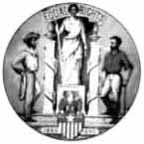
Allegorical woman flanked by two pillars, with the words "Equal Rights" on a banner above. Rancher left. Miner right. Eagle on shield. On the official version are also "Livestock, Grain, Mines, Oil, 1869-1890."
|